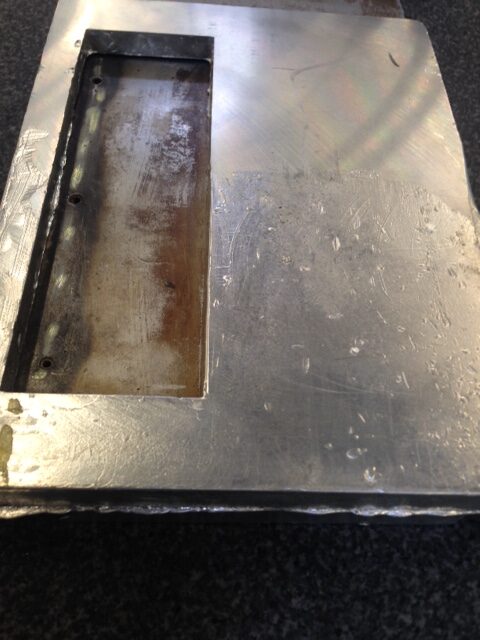The following is a case study on why it’s not just the quality and design of your sawguide that you need to look out for, but the quality and design of your Babbitt pad and pocket as well.
The other day, I received a sawguide sample from a new customer who had just placed a purchase order. For new customers, our process is to send their sawguide sample to our Quality Control department to be scanned. This allows us to get all the dimensions from the sawguide in order to create a drawing for the customer to approve prior to our manufacturing department producing their order. Soon after I dropped off the sample at our Quality Control department, they left me a very cryptic voicemail. It went like this: “Can you please come and see us because we think there’s something wrong with the sawguide babbitt. We have never seen this configuration before!”
After receiving the message, I promptly went down to the QC department to see what the issue was. QC showed me the sawguide and I swear I have never seen this type of babbitt pad before in all my years in the industry.
The sample that our new customer had provided was a type of “mold on babbitt pad”, meaning that the babbitt is molded around the sawguide so that it becomes part of the sawguide. Contrastingly, most sawguides today have pads that are poured in a mold first, and then that molded pad is bolted to the sawguide. So this was definitely something that was out of the norm, these days.
The customer’s babbitt pad was basically a molded on solid chunk of babbitt that measured 6” wide by 8” long and about 1/2” thick. It was a pretty amazing chunk of babbitt but it had a lot of guiding surface in contact with the saw. This large amount of babbitt contact with the saw was my first clue that there was an issue with how this sawguide performed. In addition to this large contact surface, it had a coolant pocket that was 2” wide by 6“ long and 1/2” deep. I have never seen a coolant pocket that deep before. It looked like an empty swimming pool. The design and layout of this particular coolant pocket would probably work really well if it was meant for a destination holiday resort, but not for a sawguide. With that design configuration, it’s just not possible to cool the saw properly.
There were so many things wrong, on so many levels, with this babbitt pad so I decided that it would be best to call the customer and explain the situation. By just looking at the babbitt pad, I knew that the customer was most likely having a lot of heat issues with their saws. It was no surprise to me that the customer confirmed that their saws were indeed running very hot. They couldn’t figure out what the problem was. The customer admitted they had resorted to a last-ditch effort of increasing the flow of coolant to the saws, but that still wasn’t helping.
It turns out that this sawguide and pad sample were both produced by a prominent manufacturer. This really upset me because it indicated to me that whoever designed this guiding system was not trained properly. After a lot of coaching, I finally convinced the customer to have Modern build a different mold for them, with a better babbitt pad design.
The current babbitt pad had a large area of engagement with the saw, meaning that too much babbitt was in contact with the saw. This increased area of engagement also heightened the amount of friction generated by the babbitt’s contact with the saw. Increased friction means increased heat.
The other major issue was the depth and size of the babbitt pocket, which was more like a babbitt swimming pool in this case. The babbitt pocket was too deep and too small of an area. If the babbitt pocket is too deep, then the pocket cannot properly fill up. When you combine this with a small pocket size relative to the size of the babbitt pad, you get very inefficient and very little cooling of the saw.
The new babbitt pad that we designed has less area of contact with the saw, as well as a coolant pocket that is shallower, but larger in area. This will decrease the friction from the babbitt and increase the cooling capability of the pocket, which will dramatically improve the heat problems that the customer was experiencing with their saws.
It’s too bad that the customer had to suffer through many years with their prior inefficient babbitt design, but I’m sure that things will be better now. The redesigned babbitt pad we provided will result in fewer problems with sawing which will lead to an increase in productivity – something every sawmill wants.
If you need a good swimming pool designer, I think I know a company that can do the job, but please keep them away from your babbitt pad.
Author: Udo Jahn
Want my opinion direct to your Inbox? Subscribe here.

